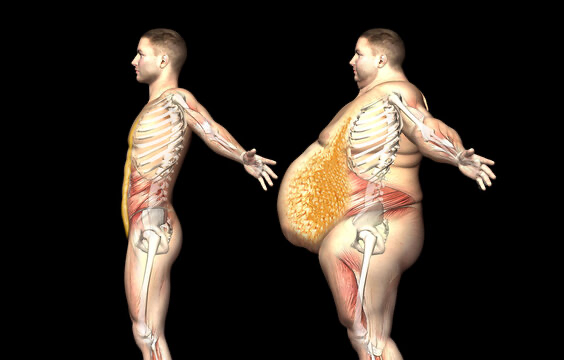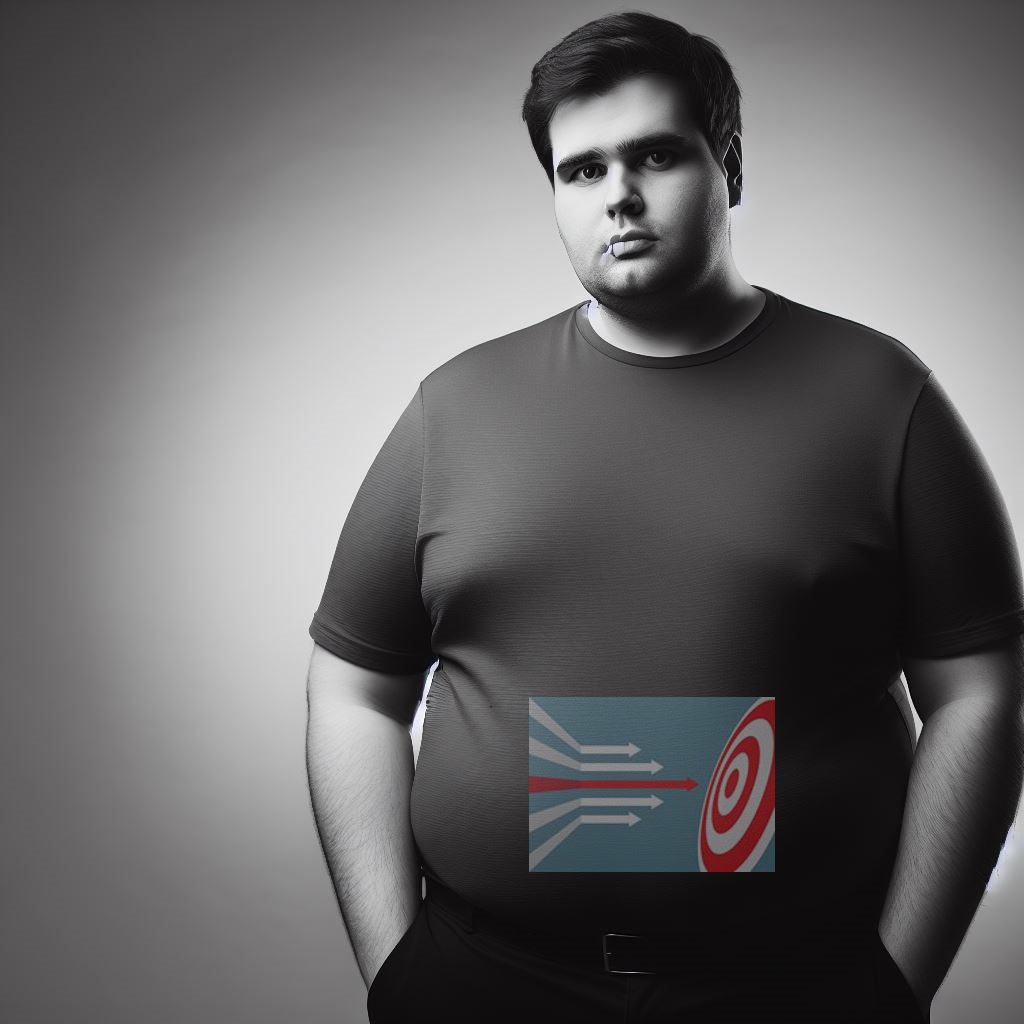This post may contain affiliate links which means I may receive a commission for purchases made through links. Learn more about policies on my about page.
Table of Contents
Visceral fat and subcutaneous fat are two types of fat found in the body. While subcutaneous fat is located just beneath the skin, visceral fat is found deep within the abdominal cavity, surrounding vital organs such as the liver, pancreas, and intestines. Understanding the differences between these two types of fat is crucial for anyone wanting to improve their overall health and reduce the risk of certain diseases. In this blog post, we will delve into the distinct characteristics of visceral and subcutaneous fat, their impact on health, and strategies to manage and reduce them effectively.
Understanding Body Fat
What is Visceral Fat?
Visceral fat is a type of body fat that is stored within the abdominal cavity, surrounding vital organs such as the liver, pancreas, and intestines. It is also known as “active fat” as it can affect hormone function and cause inflammation, leading to health issues such as heart disease and type 2 diabetes.
What is Subcutaneous Fat?
Subcutaneous fat, on the other hand, is the fat that is stored directly beneath the skin. It is the most common type of fat in the body and is responsible for the soft and pinchable areas on the body. While it is important for storing energy and insulating the body, excessive subcutaneous fat can also contribute to health problems such as obesity and cellulite.
Visceral Fat vs Subcutaneous Fat: How to Tell
Distinguishing between visceral and subcutaneous fat can be challenging as they both contribute to overall body fat. However, a typical way to differentiate them is by considering their location and texture. Visceral fat is located deep within the abdomen and cannot be pinched, while subcutaneous fat is found directly under the skin and can be pinched.
For more information on the impact of body fat on health, you can refer to the resources provided by the National Health Service, which offers detailed insights into the effects of visceral and subcutaneous fat on the body.
Location and Distribution

Appearance of Subcutaneous Fat vs Visceral Fat
Subcutaneous fat is located just beneath the skin, and it is the fat you can pinch with your fingers. It often accumulates in areas such as the thighs, hips, and abdomen, giving a softer and more superficial appearance. In contrast, visceral fat is found deeper within the abdominal cavity, surrounding vital organs. It gives the abdomen a hard, round, and protruding appearance.
Visceral Fat Distribution
Visceral fat tends to accumulate around the abdominal organs, including the liver, pancreas, and intestines. This type of fat can also extend to the chest and back area, contributing to an “apple-shaped” physique. Its distribution can lead to health issues such as insulin resistance, inflammation, and metabolic disturbances.
Subcutaneous Fat Distribution
Subcutaneous fat is spread throughout the body, particularly in the thighs, buttocks, and upper arms. It provides cushioning and insulation and is less metabolically active than visceral fat. However, an excessive amount of subcutaneous fat, especially around the abdomen, can still pose health risks and impact overall body composition.
For more detailed information on the distribution and impact of visceral and subcutaneous fat, refer to reputable sources such as the World Health Organization and the National Health Service.
Health Implications

Health Risks Associated with Visceral Fat
Visceral fat, often referred to as belly fat, is located deep within the abdominal cavity and surrounds vital organs such as the liver, pancreas, and intestines. Its excessive accumulation poses serious health risks, as it is metabolically active and can release fatty acids, inflammatory substances, and hormones that can disrupt the normal functioning of these organs. Research has shown that high levels of visceral fat are strongly associated with an increased risk of developing serious health conditions such as type 2 diabetes, heart disease, stroke, and certain types of cancer.
Health Risks Associated with Subcutaneous Fat
Subcutaneous fat, found just beneath the skin, is the fat that can be pinched and measured. While it may contribute to a higher overall body fat percentage, it is considered less harmful than visceral fat. However, excessive subcutaneous fat can still lead to health concerns, particularly if it accumulates around certain areas such as the thighs and buttocks. This type of fat has been associated with a higher risk of developing issues such as joint problems, sleep apnoea, and metabolic syndrome.
For more detailed information about the health risks associated with visceral and subcutaneous fat, you can refer to the NHS website by clicking here and here.
Measurement and Assessment
When it comes to understanding the distribution of fat in the body, it’s essential to consider the methods used to measure visceral fat and subcutaneous fat. These measurements provide valuable insights into an individual’s overall health and risk of certain conditions.
Methods to Measure Visceral Fat
- Waist Circumference: This method involves measuring the circumference of the waist at a point above the hip bone. A high waist circumference is indicative of excess visceral fat and an increased risk of health complications.
- MRI and CT Scans: These imaging techniques allow for a direct assessment of visceral fat by creating detailed cross-sectional images of the body. While highly accurate, these methods are more costly and less accessible.
- Bioelectrical Impedance Analysis (BIA): BIA measures body composition by analyzing the body’s resistance to low-level electrical currents. Specialised scales can provide an estimate of visceral fat levels.
Methods to Measure Subcutaneous Fat
- Skinfold Calipers: Skinfold measurements are taken at specific sites on the body using calipers. These measurements can estimate the amount of subcutaneous fat present, but they may not distinguish between subcutaneous and visceral fat.
- Ultrasound: This imaging method uses sound waves to create a visual representation of the subcutaneous fat layer beneath the skin. It is commonly used to measure fat thickness at specific sites on the body.
- DEXA Scan: Originally designed to measure bone density, Dual-Energy X-ray Absorptiometry (DEXA) scans can also provide detailed information about total body composition, including subcutaneous fat levels.
For more detailed information on these measurement methods, you can visit the National Institute of Diabetes and Digestive and Kidney Diseases and the British Nutrition Foundation.
Factors Influencing Fat Distribution
Our body’s fat distribution is influenced by a variety of factors, including genetic and lifestyle elements. Understanding these factors can shed light on why fat accumulates in certain areas and provide insight into effective strategies for managing it.
Genetic Factors
Genetics play a significant role in determining where your body stores fat. Studies have shown that certain genetic variations can predispose individuals to store fat in specific areas, such as the abdomen or hips. This phenomenon contributes to the diversity of body shapes and sizes observed across different populations.
Lifestyle Factors
In addition to genetic predispositions, lifestyle factors also play a crucial role in fat distribution. Dietary habits, levels of physical activity, stress management, and sleep patterns all impact where and how fat is stored in the body. A sedentary lifestyle coupled with a high-calorie diet can lead to the accumulation of visceral fat, while regular exercise and a balanced diet can help maintain a healthy fat distribution pattern.
By understanding the interplay between genetic and lifestyle factors, individuals can make informed choices to promote a healthier fat distribution and overall well-being.
For more information on genetic factors influencing fat distribution, you can refer to the National Institute of Diabetes and Digestive and Kidney Diseases. To explore the impact of lifestyle factors on fat distribution, consider visiting the Mayo Clinic’s guide to healthy lifestyle.
Strategies for Reduction of body fats

Targeting Visceral Fat
Visceral fat, also known as belly fat, is a major concern for many people due to its association with various health risks. One effective strategy for reducing visceral fat is through regular aerobic exercise. Activities like brisk walking, cycling, and swimming can help burn calories and reduce visceral fat. Additionally, incorporating strength training exercises into your routine can also be beneficial, as it helps build muscle mass, which in turn can aid in burning visceral fat. Moreover, adopting a balanced diet that is low in added sugars and refined carbohydrates while being rich in fiber, lean protein, and healthy fats can also contribute to reducing visceral fat.
For more information on the impact of exercise on visceral fat, visit Healthline
Targeting Subcutaneous Fat
Subcutaneous fat is the fat that lies just beneath the skin. While it is generally less concerning in terms of health risks compared to visceral fat, many people still seek ways to reduce it for aesthetic reasons. One effective strategy for reducing subcutaneous fat is through a combination of cardiovascular exercise and a balanced diet. Engaging in activities like running, dancing, or high-intensity interval training (HIIT) can help burn calories and reduce overall body fat, including subcutaneous fat. Additionally, focusing on a diet that is high in lean protein, whole grains, fruits, and vegetables while moderating the intake of fats and sugars can contribute to the reduction of subcutaneous fat.
For further insight into reducing subcutaneous fat, visit Medical News Today
Conclusion
Visceral fat and subcutaneous fat are two types of fat that exist in the body. Visceral fat is located deep within the abdomen and surrounds vital organs, while subcutaneous fat is found just beneath the skin. Understanding the differences between these two types of fat is crucial for managing one’s overall health. By prioritising a balanced diet, regular exercise, and healthy lifestyle choices, individuals can work towards reducing visceral fat and promoting overall well-being. It’s important to remember that both types of fat play distinct roles in the body, and a holistic approach to health is key in maintaining a healthy balance.

